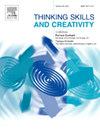Creative thinking in language learning classes: An analysis of educational policy in Moroccan public primary schools
IF 3.7
2区 教育学
Q1 Social Sciences
引用次数: 0
Abstract
Creative thinking is considered one of the essential skills of the 21st century that should be promoted throughout the educational system, particularly in primary schools across all subjects, including language classes. The first step in effectively developing creative thinking in schools is to provide a curriculum with clear guidelines on how to foster this skill. Educational policy documents are of paramount importance because they outline the content and processes that should be communicated in the classroom. The current article reports the findings of an analysis of five Moroccan educational policy documents namely, The National Charter for Education and Training (1999), The White Paper (2002), The Strategic Vision of 2015–2030, The Framework Law 51–17 (2019), and The Primary Education Curriculum (2021). The analysis centers on two key questions: how creative thinking is defined and described in Moroccan educational policy documents, and how the importance of integrating this skill is articulated, particularly in the context of language learning classes. Our analysis reveals that educational policy documents do not offer a clear and operational definition of creativity, and the term is used differently across school subjects. The provided descriptions of the skill are all positive, suggesting that it is not perceived as a negative attribute. However, the documents do not offer guidance on how teachers should develop creative thinking. Additionally, educational policy documents often equate creativity with artistic production. This suggests that educational policy makers have a bias or preference for thinking mainly about artistic work when considering activities that promote creative thinking. The study concludes with practical recommendations for policymakers to effectively integrate the promotion of creative thinking in language education through educational policy documents.
求助全文
约1分钟内获得全文
求助全文
来源期刊

Thinking Skills and Creativity
EDUCATION & EDUCATIONAL RESEARCH-
CiteScore
6.40
自引率
16.20%
发文量
172
审稿时长
76 days
期刊介绍:
Thinking Skills and Creativity is a new journal providing a peer-reviewed forum for communication and debate for the community of researchers interested in teaching for thinking and creativity. Papers may represent a variety of theoretical perspectives and methodological approaches and may relate to any age level in a diversity of settings: formal and informal, education and work-based.
 求助内容:
求助内容: 应助结果提醒方式:
应助结果提醒方式:


